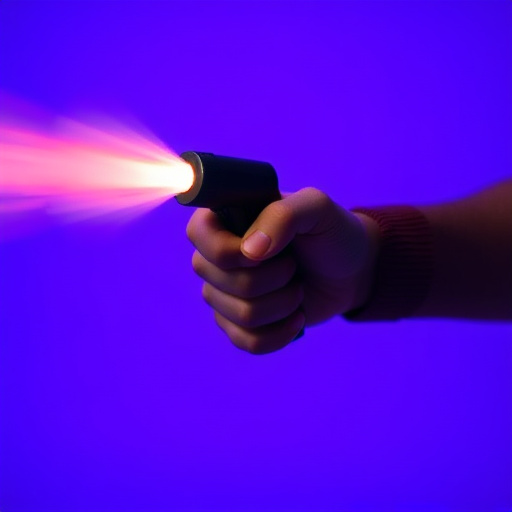Pepper spray canisters, effective for riot control and self-defense, rely on understanding their composition and wind direction for optimal use. Aiming at faces, using short bursts, and considering wind patterns (up to 30 feet reach in low winds) prevent blowback. Mastering wind direction techniques through training enhances accuracy and de-escalation strategies, ensuring safe use while prioritizing bystander protection. Key safety measures include protective gear, controlled environment practice, and responsible deployment as a last resort, adhering to manufacturer guidelines for storage and usage.
“Uncovering the power of riot control tools, this article delves into the versatile and potent pepper spray canister. From its intricate composition designed for effectiveness to mastering wind direction for precise deployment, we explore essential tips for optimal use. Learn about safety considerations and real-world applications, including scenarios where pepper spray canisters prove indispensable. Discover how to harness these tools’ potential while understanding their impact on crowd control. Get equipped with valuable insights, especially in the context of wind direction tips for accurate deployment.”
- Understanding Pepper Spray Canisters: Their Composition and Effectiveness
- Mastering the Wind Direction: Tips for Accurate Deployment
- Safety Considerations: Handling and Training for Optimal Results
- Real-World Applications: When and How to Use Pepper Spray Canisters
Understanding Pepper Spray Canisters: Their Composition and Effectiveness
Pepper spray canisters, also known as inflammatory spray canisters, are powerful tools used for riot control and self-defense. These devices contain a concentrated solution of capsaicin, a chemical derived from chili peppers, which is designed to cause irritation and temporary blindness when sprayed into the eyes and respiratory system of a target. Each canister typically holds a specific amount of solution, delivered through a nozzle that can be actuated with a trigger mechanism.
Effective use of pepper spray requires understanding its composition and behavior. The wind direction plays a crucial role in determining its reach and impact. Tips for optimal usage include aiming at the face and eyes, using short bursts to minimize spreading, and considering the wind’s direction to ensure the spray doesn’t blow back onto the user. In low-wind conditions, pepper spray can travel up to 30 feet; however, in windy environments, it may only reach a few feet, making precise targeting essential for safety and effectiveness.
Mastering the Wind Direction: Tips for Accurate Deployment
Mastering the wind direction is a crucial skill for effective deployment of pepper spray canister. When faced with a riotous situation, understanding how wind blows and its impact on aerosol dispersion can significantly enhance your control. Before firing, assess the environment—is the wind blowing towards or away from you? A gentle breeze in your favor might carry the spray further, covering more ground. Conversely, a strong gust against you could limit the reach, leaving some areas unprotected.
For optimal accuracy, aim slightly into the wind. This technique allows the pepper spray to travel with the airflow, ensuring it reaches its intended targets. Practice this maneuver during training sessions to become adept at judging wind direction and timing your deployments accordingly. Remember, precise application of force is key to de-escalating tensions without causing harm to innocent bystanders.
Safety Considerations: Handling and Training for Optimal Results
When handling riot control inflammatory spray canisters, safety is paramount. It’s crucial to understand the pepper spray wind direction tips for optimal effectiveness and to minimize exposure to both yourself and bystanders. Always wear protective gear, including eye protection, during use, as pepper spray can cause severe irritation or damage.
Training is essential to ensure that users are familiar with the spray canister’s operation, timing, and range. Practice in controlled environments allows individuals to learn proper technique, including aiming, distance, and follow-up actions. Additionally, understanding local regulations and de-escalation strategies is vital for responsible and effective use of riot control inflammatory spray canisters.
Real-World Applications: When and How to Use Pepper Spray Canisters
In real-world scenarios, pepper spray canisters have proven invaluable for riot control and personal defense. Law enforcement agencies often employ them to manage large crowds during protests or public disturbances, as the immediate effect of the spray can quickly de-escalate tense situations. When using pepper spray, understanding the wind direction is crucial for optimal results. It’s recommended to aim slightly upwards and into the wind, ensuring the spray forms a dense cloud that lingers in the target area. This tactic is particularly effective outdoors, where wind patterns can carry the irritant away from bystanders and towards the intended aggressors.
Proper timing and technique are essential when deploying pepper spray. Users should take cover immediately after releasing the canister to avoid inhaling the spray themselves. It’s also important to be aware of potential resistance or countermeasures individuals might employ, such as removing glasses or covering their faces, so adjustments can be made accordingly. Pepper spray is best used as a last resort when other de-escalation methods have failed, and it should always be handled and stored according to manufacturer guidelines to ensure safety and effectiveness.
Pepper spray canisters, a powerful tool in riot control, rely on understanding their composition and effective deployment strategies. By mastering wind direction techniques and prioritizing safety through proper handling and training, users can ensure optimal results. These canisters prove invaluable in real-world scenarios, offering a swift and strategic solution when faced with chaotic situations, all while considering the crucial elements of wind direction tips for accurate application.
